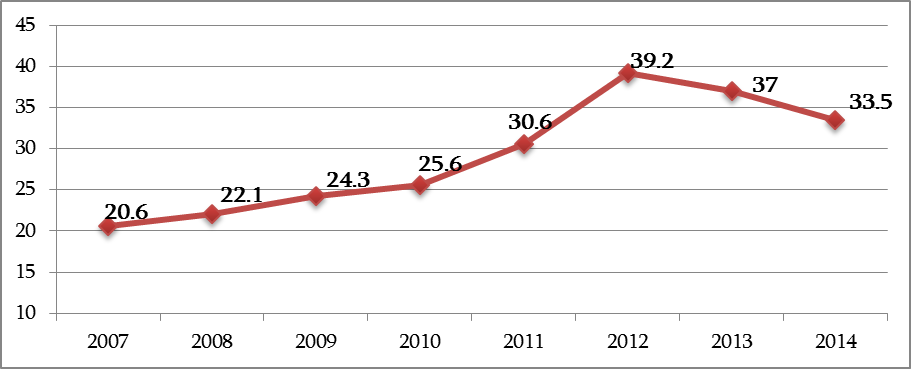The Chair of the Healthcare and Social Issues Committee of the Parliament of Georgia, Dimitri Khundadze, in his speech before the Parliament of Georgia stated: "The number of abortions has dropped considerably. In the period of one year, throughout 2014, the number of abortions decreased by 7,000 whilst in the last six years we used to have an annual increase in the number of abortions by 1,000-2,000."
FactCheck took interest in Dimitri Khundadze’s statement and verified its accuracy.
According to the National Statistics Office of Georgia, the number of registered abortions in Georgia had a growth trend in the period of 2008-2012. The largest number of abortions (39,200) coupled with their highest growth rate in terms of percentage (28%) was registered in 2012. In 2013, there were 2,200 less abortions as compared to 2012. The number dropped by an even further 3,500 in 2014.
Graph 1: Number of Abortions in 2007-2014 (Thousands)

According to the statistics of 2009-2014, the highest number of abortions is registered in the category of women aged 20-44 years (see Table 1).
Table 1: Number of Abortions According to Age
|
2009 |
2010 |
2011 |
2012 |
2013 |
2014 |
| Under 15 years |
21 |
14 |
15 |
19 |
34 |
20 |
| 15-19 years |
1,689 |
1,770 |
1,681 |
1,955 |
1,833 |
1,387 |
| 20-44 years |
22,419 |
23,664 |
28,760 |
37,070 |
43,881 |
31,850 |
| 45 years and more |
182 |
137 |
134 |
181 |
270 |
212 |
According to the data of the National Centre for Disease Control and Public Health (NCDC), the total number of abortions, including artificial abortions, did drop in 2014. However, the number of medical abortions increased.
Table 2: Ratio of Medical Abortions in Total Number of Abortions
|
2013 |
2014 |
| Total Number of Abortions |
37,018 |
33,469 |
| Artificial Abortions |
30,726 |
27,637 |
| Ratio of Medical Abortions in the Total Number of Artificial Abortions |
21.2% |
28.1% |
FactCheck tried to determine the factors contributing to the decrease in the number of abortions. In 2013, the Universal Healthcare Programme was launched which envisages the funding of childbirth together with other medical services. Additionally, pregnant women are able to use the service of free consultation with a doctor and conduct a basic medical analysis four times during their pregnancy. In parallel, the duration of maternity leave and the amount of labour remuneration were increased which could also have had a positive impact upon the drop in the number of abortions.
The state has undertaken other specific measures to combat abortions as well. In 2014, selective abortions (depending upon the sex of a child) were banned. This means that parents are not allowed to know the sex of their child until the time when abortion is no longer allowed (abortion is legal in Georgia during the first 12 weeks of pregnancy). Of additional note is that the time in which to make a final decision about an abortion was increased from three to five days. Moreover, the penalty for illegal abortions has been made stricter since 20 October 2014. Before the imposition of stricter laws, illegal abortions were punished by a fine or public labour (from 100 to 240 hours) or by corrective labour (from one year to two years). After the aforementioned changes, a fine is no longer the form of penalty. Illegal abortions are punished by public labour from 120 to 300 hours or by jail sentence from one to two years. The punishment became stricter in those cases when illegal abortion is repeated, caused grave consequences (such as the loss of the ability to bear a child) or death (see
FactCheck’s
article on this topic).
The aforementioned legal changes will have a positive impact upon the decrease in the number of abortions in the future. However, they could not have influenced the statistics for 2013 and only partially, if at all, influenced the numbers for 2014. Improved reproductive health comprising planned parenthood in tandem with access to safe and effective contraception has the greatest impact upon the drop in the number of abortions.
Conclusion
According to the data of the National Statistics Office of Georgia, the number of registered abortions in 2014 dropped by 3,500. The number of abortions also dropped by 2,200 in 2013. Of particular note is that the number of abortions in previous years (2008-2012) exhibited an annual increase.
Specific steps made by the state together with improved reproductive health have contributed to the decrease in the number of abortions. In particular, these include legislative changes enacted in 2014 to include a ban on selective abortions, an increase in the time period from three to five days for deciding upon an abortion and a toughening of legal penalties for illegal abortions. All of these should contribute towards a further decrease in the number of abortions in the long-term perspective.
Even though the number given by Dimitri Khundadze is not correct, it is indeed true that the number of abortions in 2013-2014 dropped considerably in response to specific steps made by the state against abortions.
Therefore,
FactCheck concludes that Dimitri Khundadze’s statement is
TRUE.
 According to the statistics of 2009-2014, the highest number of abortions is registered in the category of women aged 20-44 years (see Table 1).
Table 1: Number of Abortions According to Age
According to the statistics of 2009-2014, the highest number of abortions is registered in the category of women aged 20-44 years (see Table 1).
Table 1: Number of Abortions According to Age
 According to the statistics of 2009-2014, the highest number of abortions is registered in the category of women aged 20-44 years (see Table 1).
Table 1: Number of Abortions According to Age
According to the statistics of 2009-2014, the highest number of abortions is registered in the category of women aged 20-44 years (see Table 1).
Table 1: Number of Abortions According to Age







